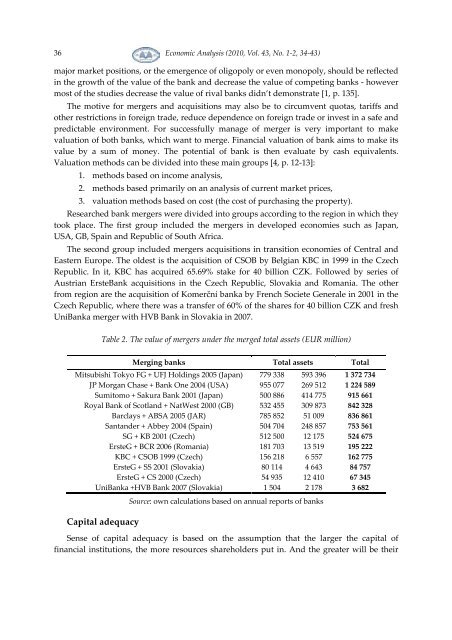Twice a Year Scientific Journal
Twice a Year Scientific Journal
Twice a Year Scientific Journal
Create successful ePaper yourself
Turn your PDF publications into a flip-book with our unique Google optimized e-Paper software.
36<br />
Economic Analysis (2010, Vol. 43, No. 1-2, 34-43)<br />
major market positions, or the emergence of oligopoly or even monopoly, should be reflected<br />
in the growth of the value of the bank and decrease the value of competing banks - however<br />
most of the studies decrease the value of rival banks didn’t demonstrate [1, p. 135].<br />
The motive for mergers and acquisitions may also be to circumvent quotas, tariffs and<br />
other restrictions in foreign trade, reduce dependence on foreign trade or invest in a safe and<br />
predictable environment. For successfully manage of merger is very important to make<br />
valuation of both banks, which want to merge. Financial valuation of bank aims to make its<br />
value by a sum of money. The potential of bank is then evaluate by cash equivalents.<br />
Valuation methods can be divided into these main groups [4, p. 12-13]:<br />
1. methods based on income analysis,<br />
2. methods based primarily on an analysis of current market prices,<br />
3. valuation methods based on cost (the cost of purchasing the property).<br />
Researched bank mergers were divided into groups according to the region in which they<br />
took place. The first group included the mergers in developed economies such as Japan,<br />
USA, GB, Spain and Republic of South Africa.<br />
The second group included mergers acquisitions in transition economies of Central and<br />
Eastern Europe. The oldest is the acquisition of CSOB by Belgian KBC in 1999 in the Czech<br />
Republic. In it, KBC has acquired 65.69% stake for 40 billion CZK. Followed by series of<br />
Austrian ErsteBank acquisitions in the Czech Republic, Slovakia and Romania. The other<br />
from region are the acquisition of Komerční banka by French Societe Generale in 2001 in the<br />
Czech Republic, where there was a transfer of 60% of the shares for 40 billion CZK and fresh<br />
UniBanka merger with HVB Bank in Slovakia in 2007.<br />
Table 2. The value of mergers under the merged total assets (EUR million)<br />
Merging banks Total assets Total<br />
Mitsubishi Tokyo FG + UFJ Holdings 2005 (Japan) 779 338 593 396 1 372 734<br />
JP Morgan Chase + Bank One 2004 (USA) 955 077 269 512 1 224 589<br />
Sumitomo + Sakura Bank 2001 (Japan) 500 886 414 775 915 661<br />
Royal Bank of Scotland + NatWest 2000 (GB) 532 455 309 873 842 328<br />
Barclays + ABSA 2005 (JAR) 785 852 51 009 836 861<br />
Santander + Abbey 2004 (Spain) 504 704 248 857 753 561<br />
SG + KB 2001 (Czech) 512 500 12 175 524 675<br />
ErsteG + BCR 2006 (Romania) 181 703 13 519 195 222<br />
KBC + CSOB 1999 (Czech) 156 218 6 557 162 775<br />
ErsteG + SS 2001 (Slovakia) 80 114 4 643 84 757<br />
ErsteG + CS 2000 (Czech) 54 935 12 410 67 345<br />
UniBanka +HVB Bank 2007 (Slovakia) 1 504 2 178 3 682<br />
Capital adequacy<br />
Source: own calculations based on annual reports of banks<br />
Sense of capital adequacy is based on the assumption that the larger the capital of<br />
financial institutions, the more resources shareholders put in. And the greater will be their
















